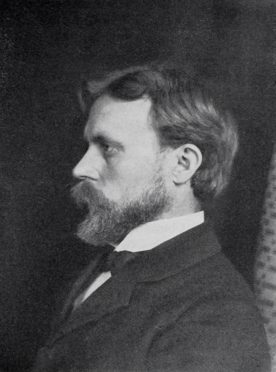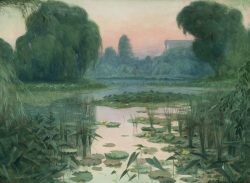Svend Svendsen, from a photograph reproduced in “Svend Svendsen and His Work,” Arts for America 6 (Feb. 1897).

Svend Svendsen 1864–1945
Born in Nittedal, Norway, Svend Rasmussen Svendsen immigrated to Chicago in 1881 to work as a lithographic artist. Largely self-taught, Svendsen had been inspired to become an artist by a youthful encounter with the great Norwegian landscape painter Fritz Thaulow, who continued to influence and inspire his work. Svendsen followed Thaulow’s penchant for painting snowy wintertime scenery but he also made coastal and marine views. His approach was marked by a “fearless” use of heightened color: his favorite motif was snow-covered ground cast in startlingly intense pinks and purples by the glancing light of sunset and encroaching shadow.i Svendsen’s exhibition debut, in 1895, was a remarkable one: his sole entry in the Young Fortnightly Club competitive exhibition—added too late for listing in the accompanying catalogue—garnered the one-hundred-dollar prize for the best oil painting produced that year that had not previously been exhibited. Lauded as one of Chicago’s most important modernist landscape painters, Svendsen went to Paris in 1896 to study at the Académie Delecluse.
In the following decade, Svendsen’s twilight, dawn, and moonlight landscape views continued to draw attention. He found many of his subjects in his native region, to which he returned several times. His works were shown frequently at Thurber’s Art Galleries in Chicago; he also participated in expositions in Nashville, Tennessee, in 1897 and in St. Louis in 1904, when he won a bronze medal. Integrating dramatic, even eccentric color and moody tonality, Svendsen’s paintings appealed to Chicagoans around the turn of the twentieth century for their inherently romantic, intimate approach to landscape. After about 1908, however, Svendsen essentially disappeared from the city’s art scene, a victim of poverty compounded by alcoholism. In the 1920s, a patron’s efforts to revive his career failed and the artist spent his last years in obscurity. Svendsen’s death was reported erroneously in 1930, but a 1945 obituary for the “famous scenic artist” in the Chicago Tribune establishes the actual date.ii
Wendy Greenhouse, PhD
i M. S. N., “Art,” Chicago Inter Ocean, Oct. 31, 1897.
ii “Svend Svendsen, Famous Scenic Artist, Is Dead,” Chicago Tribune, Sept. 7, 1945.
